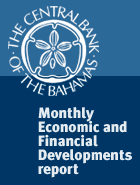| Source: Date: Updated: |
Central Bank of The Bahamas
Friday, April 5, 2013 Friday, April 5, 2013 |
Preliminary indicators suggest that domestic economic conditions remained relatively subdued over the review month, amid sustained foreign investment-led construction activity, although some signs of softness were evident in the key tourism sector. Consumer price developments featured an incremental rise in domestic energy costs, as international oil prices remained elevated. On the fiscal side, the overall deficit widened over the seven months of FY2012/13, reflecting a combination of tax-revenue related declines and higher spending. For the monetary outcome, both banking sector liquidity and external reserves contracted, in response to heightened foreign currency demand to facilitate import payments.
As an early indicator of tourism activity, data from a sample of large hotels in New Providence and Paradise Island showed total room revenues lower by 6.3% in February, as a decrease in room stock at one property combined with a one day reduction in the number of available room nights relative to last year, contributed to a 4.1 percentage point contraction in the occupancy rate to 65.9%. In contrast, the average daily room rate firmed by 5.5%, reflecting increases in over half of the hotel properties. For the performance over the first two months of the year, hotel receipts decreased by 4.1%, as the contraction in the average occupancy rate, by 2.8 percentage points to 61.7%, eclipsed the 4.5% rise in the average daily room rate to $246.10.
Consumer price movements for February featured average price gains for both gasoline and diesel, by 4.9% and 1.6% over the previous month, and by 0.2% and 1.2% year-on-year, to $5.32 and $5.21 per gallon, respectively. However, the monthly Bahamas Electricity Corporation’s fuel charge stabilized at 25.34¢ per kilowatt hour, and declined by 2.7% from the previous year’s level.
Preliminary data on the fiscal outcome for the seven months to January 2013 of FY2012/13 showed continued deterioration in the overall deficit which widened by over two-thirds vis-à-vis the comparative fiscal period, to $313.1 million. Total revenue declined by $50.0 million (6.0%) to $787.9 million, which represented an estimated 51.3% of the budget projections, while aggregate expenditure, at $1,101.0 million was higher by $74.8 million (7.3%) and equivalent to nearly 53.0% of approved estimates. The fall-off in revenue was primarily explained by an $80.7 million (18.3%) decline in taxes on international trade, as excise taxes receded by over one-third back to trend levels, following a significant one-time inflow in the previous period. In a partial offset, a one-off arrears payment contributed to a $37.9 million gain in departure taxes. Comparatively, non-tax receipts grew by $6.2 million (7.2%) to $91.9 million, supported by increases in collections of fines, forfeits & administrative fees.
Growth in expenditure was mainly attributed to a $48.5 million (5.8%) expansion in recurrent spending to $889.1 million—roughly 53% of budget estimates—buoyed by higher consumption outlays of $25.1 million (4.8%), amid increases in both personal emoluments and purchases of goods & services. In addition, transfer payments rose by $23.3 million (7.3%), due in large measure to increased subsidies for public health-related activities. Capital outlays were also higher, by $24.1 million (21.0%) to $138.8 million, primarily attributed to a $27.4 million (30.7%) rise in infrastructure-related spending, while Government’s net lending to public entities increased by $2.3 million (3.2%) to $73.1 million.
The deficit was financed mainly from domestic sources, and comprised Registered Stock ($325.0 million), Treasury bills ($54.9 million) and short-term advances ($53.0 million). External financing totalled $214.9 million and included a US$180.0 million loan, as well as draw downs from project-based borrowings.
For full text reading, please download the attached document.
![]() Source: The Central Bank of The Bahamas
Source: The Central Bank of The Bahamas











